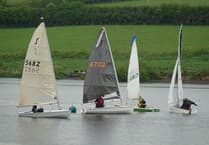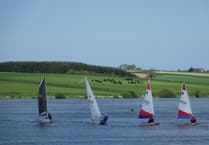The dive of the month, which was the Syracusa, which is near Newquay, was held on Thursday, August 2.
The wreck, which has been heavily salvaged, lies on a sandy seabed at 34 metres deep.
The dive began at the highest point of the wreck, by the boilers (part of the engine), which stands upright at 30 metres. The port (left-hand side) boiler is pretty much intact, while the starboard boiler (right-hand side) is opened up to display a tangle of boiler tubing, which was full of eels and small crustaceans.
Just behind the starboard boiler there was a small single-cylinder steam engine, which would have driven a pump at some point.
Behind the engine, the crankshaft is still visible with the propeller-shaft emerging from the remains of the engine-room bulkhead (wall) and continuing sternwards.
Staying on the starboard side of the ship, a cargo winch that would have served the rear holds is broken with the base upside-down. The sides of the hull have fallen outward to the seabed, leaving just a hint of where the original outline of the hull rises. The hull soon begins to narrow for the stern, with a pair of bollards fallen from a long-decayed but still upright deck just inside the hull. Coal remaining from the cargo is scattered nearby.
A few metres off the stern, and a little to starboard, lies the top of the rudder-post and the steering mechanism, an interesting dustbin-shaped casing that would have contained the gearing to turn the rudder-shaft through rotation of a horizontal steering-shaft. A little further back they found the rudder, which is perfectly positioned relative to the propeller, but with the top of the shaft bent over by almost 90 degrees.
This suggests that the Syracusa went down stern-first, so that the rudder and propeller caught on the seabed and were wrenched from the ship as it settled on the sea floor.
The divers then turned and headed back past the boilers, where the wreck then drops to the seabed again as the side of the hull has fallen outwards.
A pair of bulkheads crosses the wreck and marks the bunker space, where the coal for fuelling the ship’s boilers would have been held. In the middle of this space and towards the forward bulkhead is the helm and steering-engine.
Forward of this bulkhead and along the hold, a pair of winches rest upright on either side of the mast-foot that stands from the keel. Off to the port side, the side of the hull is again intact, with even a scrap of the main deck supported by it, though drooping slightly.
Continuing along the forward hold, the anchor-winch had fallen to rest across the keel. The starboard side of the bow has fallen inwards, while the port side of the bow has fallen outward to rest on the seabed.
Right at the tip of the bow, it is broken down almost to the keel. A pair of bollards stand upright on the coarse granite sand a couple of metres out to port.
The route back to the boilers and the shotline followed the broken starboard side of the hull where the divers searched for conger eels before ascending back to the rib.
The club would also like to congratulate Jackie Diffey, who has recently passed her BSAC snorkelling instructor course.
For more information on Bude Dive Club, visit www.budediveclub.co.uk





Comments
This article has no comments yet. Be the first to leave a comment.